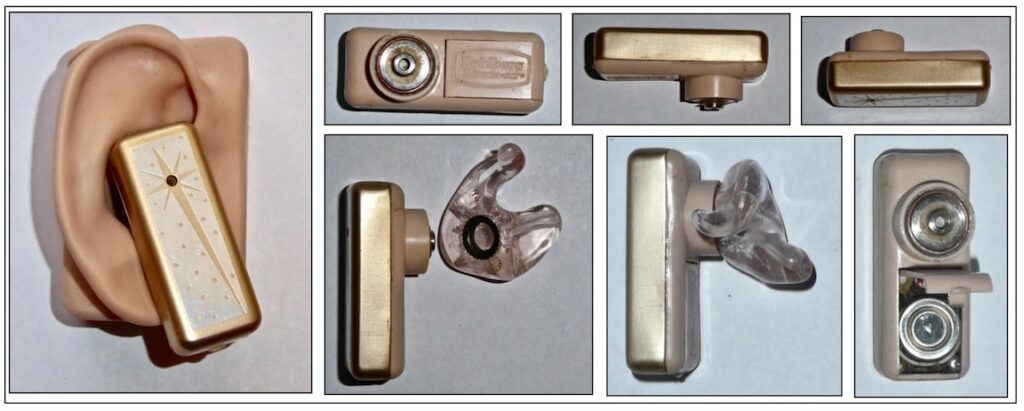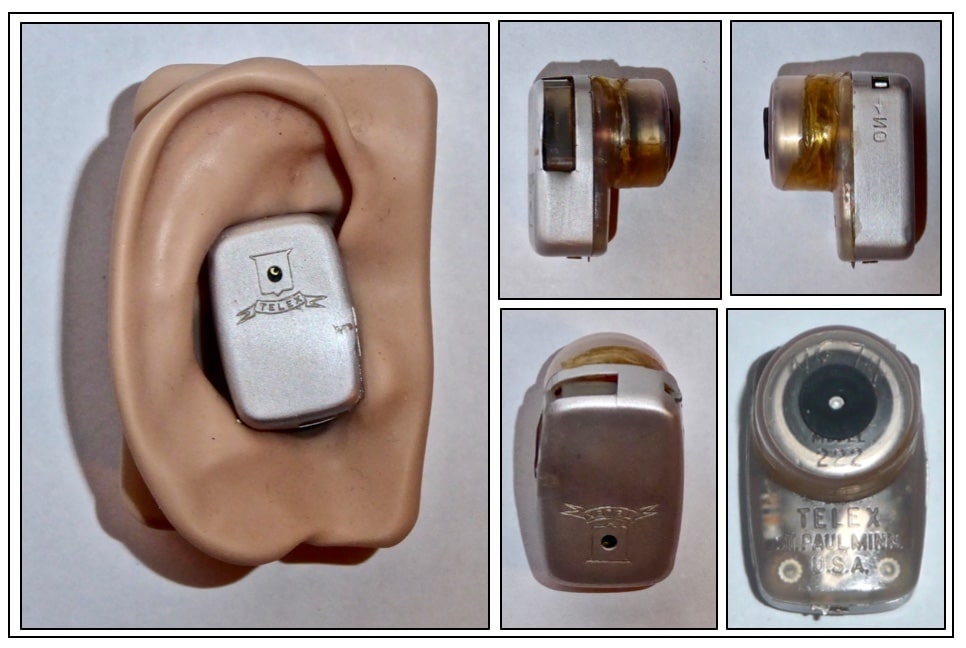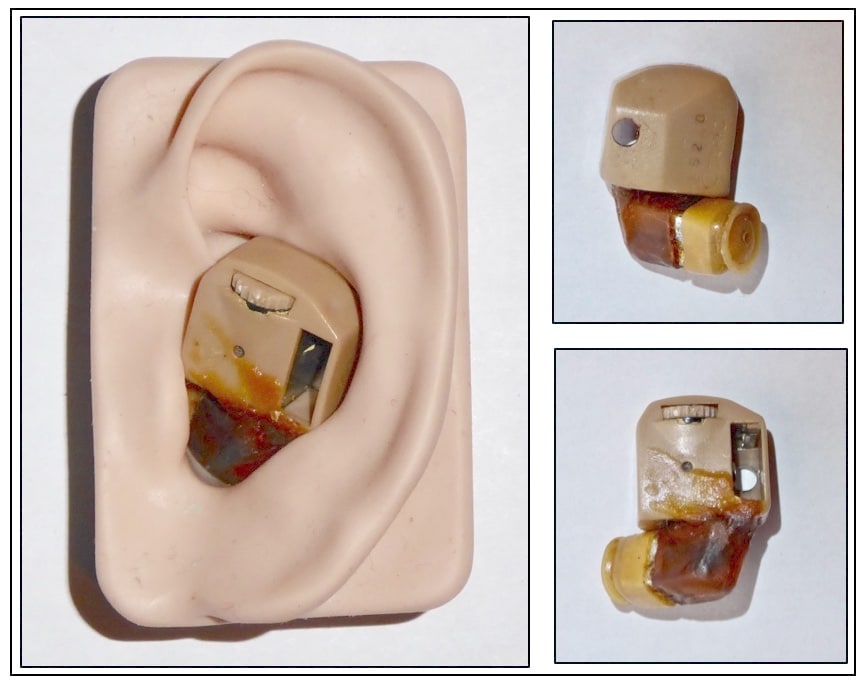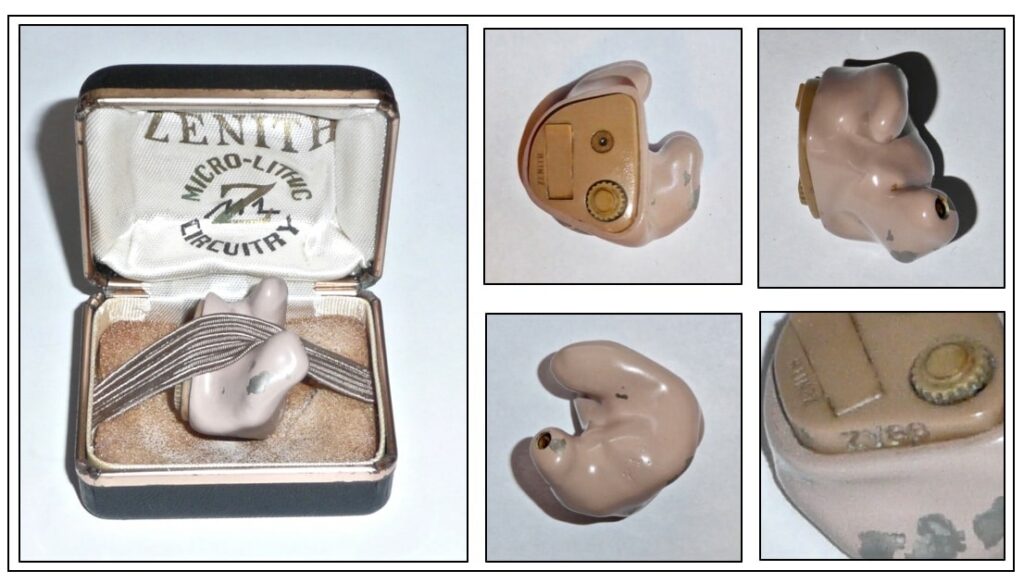My past two posts on old hearing aids have followed an historical theme based on a box of old hearing aids I uncovered in my garage recently. I actually knew they were there, but digging them out was not high on my list. However, they were uncovered when I was looking for a baling hook (unrelated to hearing aids). And, who can resist the temptation to open a box titled “Old Hearing Aids,” especially when they included what might have been among some of the first ITE hearing aids?
The initial post on these old hearing aids related mostly to eyeglass hearing aids (a hot item in its time and given substantial promotion because Eleanor Roosevelt wore eyeglass hearing aids). Last week’s post featured some of the first behind-the-ear hearing aids taken from that box.
Because the box had some additional goodies in it that had not been covered in my previous writings, this post will discuss and show some of the first in-the-ear hearing aids.
In-The-Ear Hearing Aids
It should come as no surprise to anyone working with hearing aids that the market has always been driven by cosmetics, and this relates to making hearing aids as unobtrusive as possible, meaning making them as small as possible.
In the early days, these were not referred to as in-the-ear hearing aids, but as “at-ear” hearing aids.
Unknown (Year?)
This unit from my box leads the way to the at-ear hearing aid category (Figure 1). No identification was found on this hearing aid. However, it did use a 625 cell, indicating that it used transistors of the early stages, which would put this into the early to mid 1950s. All the components, except the receiver and power supply, are contained in the larger round section.
The external receive is of the smaller size, and attached to the inner side of the hearing aid in such a way that it is embedded into the custom-made earmold. There are no controls on the instrument. Operation occurs with the insertion of the battery/cell.
If anyone has knowledge of this hearing aid, I would appreciate hearing from you.

Figure 1. Images will be identified from left to right on the top as 1, 2, 3, and on the bottom left to right as 4, 5, and 6. This unknown, at-ear hearing aid is estimated to have been produced in the early-to-mid 1950s. Image 1 This shows the hearing aid as seen from the outside, or looking into the ear. The microphone is in the middle of the outer plate. Image 2 This shows a side view of the hearing aid. Note that the button receiver is embedded into the earmold. The space between the main body and the earmold is reserved for a slide-in, friction-fit 625 cell to power the instrument. Image 3 This shows the instrument from the inside, that which is fitted to the concha and entrance of the ear canal. This is primarily the custom earmold. It is secured to the body of the instrument by two screws seen near the top of the concha area. Note also that the sound bore is constructed of tubing attached to what appears to be a “B” adapter snapped into the button receiver. Image 4 This provides another angle of the button receiver and its attachment to both the body of the instrument and to how the earmold has been hollowed out to accept the receiver, in part. Image 5 This shows a 625 cell inserted partially into an open slot between the earmold and body of the instrument. This is a friction fit, and the cell would be removed by pushing it from the opposite side, the area between the body and earmold. Image 6 The button receiver is not hard attached to the body. It is embedded into the earmold and secured with a snap-in adapter. This would allow for the receiver to be serviced, but unscrewing the two screws holding the earmold to the two upper sides of the metal battery slot. This would allow the receiver to be “unsnapped” from the earmold. The wires seen at those to the receiver and to the battery contacts.
Dahlberg Miracle Ear Model D-10 (1955)
This was called an “at ear” hearing aid, and consisted of a 3-transistor unit powered by a 400 cell. It measured 41 x 18 x 16 mm and weighed 15 grams. This may possibly have been the first commercially-made at-ear hearing aid (Figure 2). This seems to be the first product that Dahlberg identified as “Miracle Ear,” a trademark that was one of the most recognized hearing aid names among hearing aids by the general public. Prior to this, Dahlberg had used the “Magic Ear” name. A custom earmold having a snap ring was attached to the speaker nub for retention to the concha structures of the ear. Because the earmold could swivel in the receiver nub, the body of the hearing aid could be rotated and positioned were it was the most cosmetic and/or secure.

Figure 2. Dahlberg Miracle Ear, Model D-10 at-ear hearing aid is from 1955. The left of the smaller images on the top clearly shows the Miracle Ear name below Dahlberg.
Telex 222 (1957)
The Telex “Tynamite” at-ear hearing aid was a 4-transistor device powered by a 400 cell. It measured 24 x 16 x 18 mm and weighed 9 grams (Figure 3). The height measurement includes the receiver portion, and the weight is with a power cell. The model number (222) is stamped onto a thin transparent cover over the receiver face. The 222 had an On/Off switch on the bottom and a volume control slider at the top of the aid. The microphone opening was on the upper outside surface of the instrument.

Figure 3. Telex Model 222 at-ear hearing aid, introduced in 1957. The model number (222) can be seen stamped into a hard plastic covering the button receiver. It is above the Telex name. This instrument was built in the original Telex plant in St. Paul, Minnesota.
Acousticon A-410 “Receiv Ear” (1960)
This at-ear instrument was a 2-transistor hearing aid powered by a 400 cell (Figure 4). It had no volume control. The On/Off was controlled by removing the battery from the hearing aid, which was a friction fit contact. This metal-cased hearing aid was made in England and measured 20 x 19 x 15 mm and weighed 10 grams.
Figure 4. Various photos of the Acousticon A-410 “Receiv Ear”, manufactured in 1960. The battery is inserted into the removable door, and then friction-fit into the slot as shown in the series of photos on the bottom. The author has taken liberty with the left bottom photo in that it shows the battery door in its inverse position. This was done to show the artwork on the cover. The two upper left images show the hearing aid with the battery door inserted. The dark plate is actually the art cover, but the lighting ended up showing this as being a dark cover, which it is not.
Otarion ECA-1 (1961)
This was an ear canal hearing aid, also identified as the “Normalizer.” It was a 3-transistor hearing aid powered with a 312 cell in a pull-out battery holder, which also acts as the On/Off. It was available in either a left or right version. It had a volume, but no other controls. It came with an assortment of removable, friction fitting tips (Figure 5).

Figure 5. Otarion ECA-1 at-ear hearing aid from 1961. A difference with this instrument, as compared with the others discussed so far, is that it uses a miniature receiver rather than a button receiver. The battery was contained in a removable holder (missing on this hearing aid). An assortment of exchangeable fitting tips was provided with the instrument. The smallest size is shown. The instrument was either a right or left model, and had a volume control and microphone opening on the faceplate. Notice what looks like glue holding the receiver to the body. The author is unsure what this material was, but it was present on earlier button receivers as well.
Zenith Solitaire (1964)
This was a custom-like in-the-ear hearing aid (Figure 6). The electronics were housed in a stock metal shell (hard plastic covered). It used a micro-lithic integrated circuit with 6 transistors, and was powered with a silver 312 cell. The model Z (which this unit is) was for sales use.
A model X was for demonstration purposes. The microphone opening was on the upper faceplate and a volume control, without On/Off, was on the faceplate as well. The battery door had to be opened to turn the aid off. This instrument is being presented because it featured extensive circuitry used at that time, and because of the custom-like metal shell.

Figure 6. The Zenith Solitaire was introduced in 1964. The most unusual feature of this instrument was the metal housing (covered with plastic) of a custom-like shape. Some of the images show the plastic worn or chipped off. In essence, this may have been the first modular in-the-ear hearing aid. The model number is etched into the faceplate and is shown in the lower right photo.
Wayne Staab, PhD, is an internationally recognized authority in hearing aids. As President of Dr. Wayne J. Staab and Associates, he is engaged in consulting, research, development, manufacturing, education, and marketing projects related to hearing. His professional career has included University teaching, hearing clinic work, hearing aid company management and sales, and extensive work with engineering in developing and bringing new technology and products to the discipline of hearing. This varied background allows him to couple manufacturing and business with the science of acoustics to bring innovative developments and insights to our discipline. Dr. Staab has authored numerous books, chapters, and articles related to hearing aids and their fitting, and is an internationally-requested presenter. He is a past President and past Executive Director of the American Auditory Society and a retired Fellow of the International Collegium of Rehabilitative Audiology.
**this piece has been updated for clarity. It originally published on September 19, 2017






